traction control BUICK LESABRE 1993 Owners Manual
[x] Cancel search | Manufacturer: BUICK, Model Year: 1993, Model line: LESABRE, Model: BUICK LESABRE 1993Pages: 324, PDF Size: 17.02 MB
Page 92 of 324
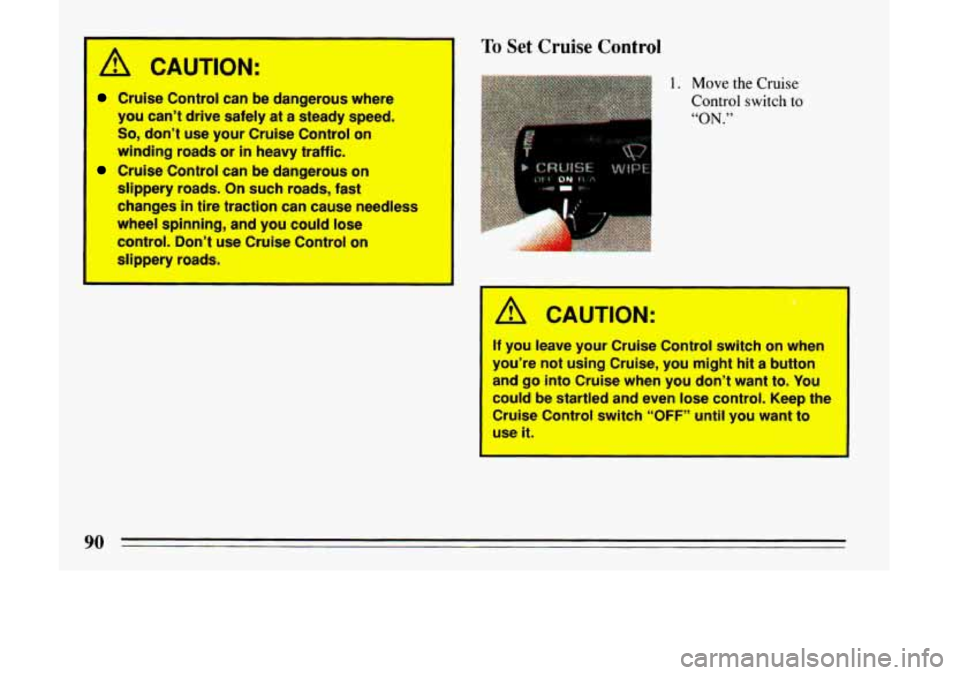
A CAUTION:
Cruise Control can be dangerous where
you can’t drive safely at a steady speed.
So, don’t use your Cruise Control on
winding roads or
in heavy traffic.
Cruise Control can be dangerous on
slippery roads. On such roads, fast
changes
in tire traction can cause needless
wheel spinning, and you could lose
control. Don’t use Cruise Control on
slippery roads.>
J
To Set Cruise Control
1.
. . . . . . .
Move the Cruise
Control switch to
“ON.”
I A CAUTION:
If you leave your Cruise Control switch on when
you’re not using Cruise, you might
hit a button
and go into Cruise when you
don’t want to. You
could
be startled and even lose control. Keep the
Cruise Control switch
“OFF” until you want to
use it.
90
Page 111 of 324
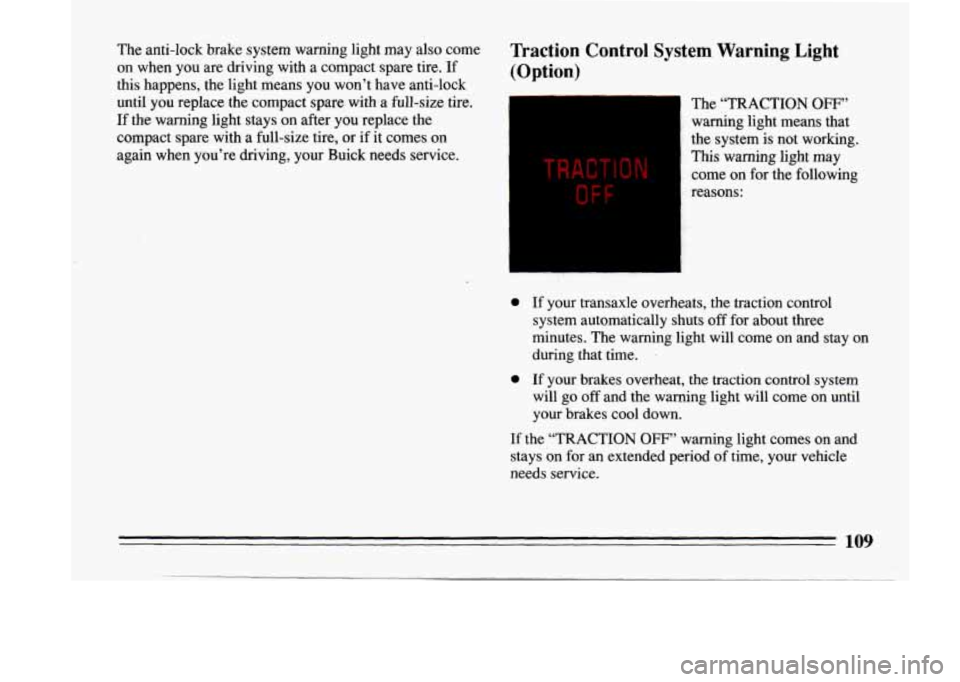
The anti-lock brake system warning light may also come Traction Control System Warning Light
on when you are driving with a compact spare tire. If (Option)
this happens, the light means you won’t have anti-lock
until you replace the compact spare with a full-size tire.
If the warning light stays on after you replace the
compact spare with a full-size tire, or
if it comes on
again when you’re driving, your Buick needs service.
TRACTION
OFF
The “TRACTION OFF”
warning light means that
the system is not working.
This warning light may
come on for the following
reasons:
0 If your transaxle overheats, the traction control
system automatically shuts
off for about three
minutes. The warning light will come on and stay on
during that time.
.
0 If your brakes overheat, the traction control system
will
go off and the warning light will come on until
your brakes cool down.
If the “TRACTION
OFF” warning light comes on and
stays on for an extended period
of time, your vehicle
needs service.
109
Page 164 of 324
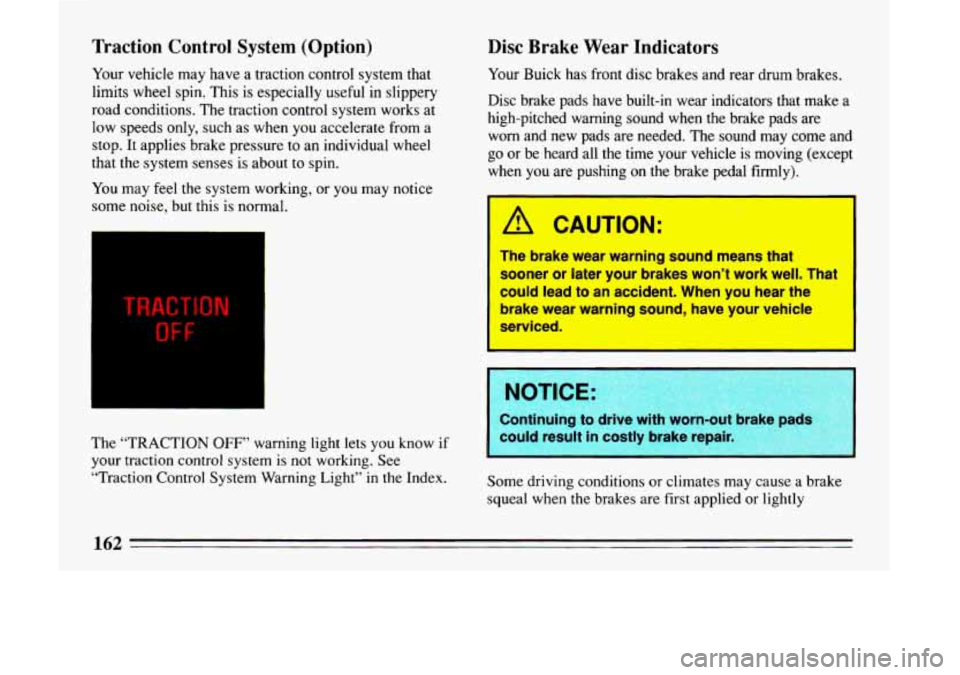
Traction Control System (Option)
Your vehicle may have a traction control system that
limits wheel spin. This is especially
useful in slippery
road conditions. The traction control system works at
low speeds only, such
as when you accelerate from a
stop. It applies brake pressure
to an individual wheel
that the system senses is about to spin.
You may feel the system working, or
you may notice
some noise, but this is normal.
OFF
The “TRACTION OFF” warning light lets you know if
your traction control system is not working. See
“Traction Control System Warning Light” in the Index.
Disc Brake Wear Indicators
Your Buick has front disc brakes and rear drum brakes.
Disc brake pads have built-in wear indicators that make a
high-pitched warning sound when the brake pads are
worn and new pads are needed. The sound may come and
go or be heard all the time your vehicle is moving (except
when you are pushing
on the brake pedal firmly).
A CAUTION:
0
The brake wear warning sound means that
sooner or later your brakes won’t work well. That
could lead to an accident. When you hear the
brake wear warning sound, have your vehicle
serviced.
Some driving conditions or climates may cause a brake
squeal when the brakes are first applied or lightly
1 LC3
Page 165 of 324
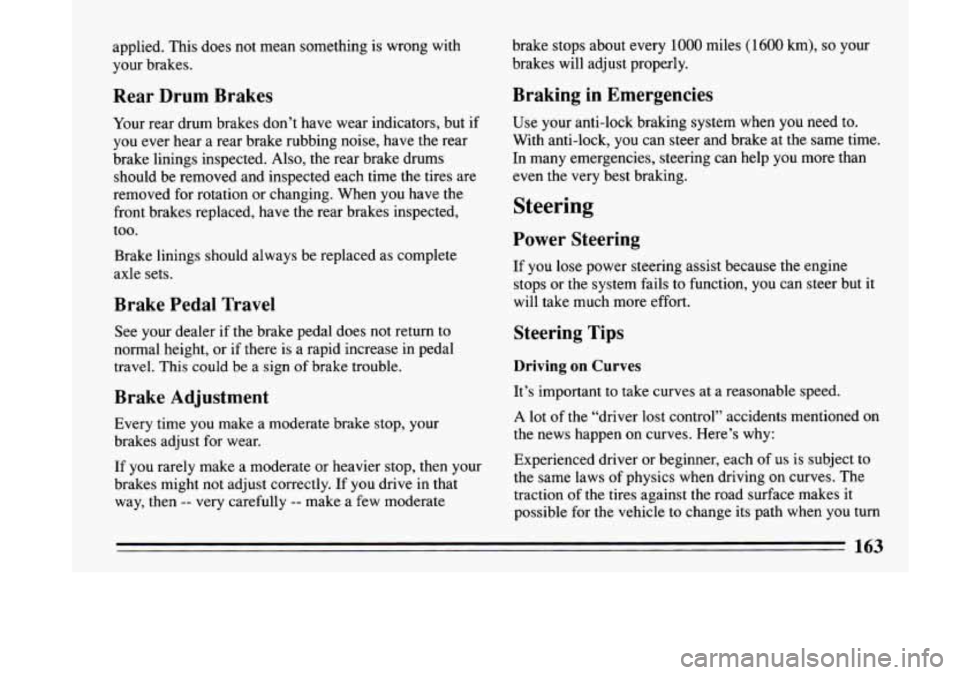
applied. This does not mean something is wrong with
your brakes.
Rear Drum Brakes
Your rear drum brakes don’t have wear indicators, but if
you ever hear
a rear brake rubbing noise, have the rear
brake linings inspected. Also, the rear brake drums should be removed and inspected each time the tires are
removed for rotation
or changing. When you have the
front brakes replaced, have the rear brakes inspected,
too.
Brake linings should always be replaced as complete
axle sets.
Brake Pedal Travel
See your dealer if the brake pedal does not return to
normal height, or
if there is a rapid increase in pedal
travel. This
could be a sign of brake trouble.
Brake Adjustment
Every time you make a moderate brake stop, your
brakes adjust for wear.
If you rarely make a moderate or heavier stop, then your
brakes might not adjust correctly. If you drive in that
way, then
-- very carefully -- make a few moderate brake
stops about every
1000 miles (1600 km), so your
brakes will adjust propexly.
Braking in Emergencies
Use your anti-lock braking system when you need to.
With anti-lock, you can steer and brake at the same time.
In many emergencies, steering can help you more than
even the very best braking.
Steering
Power Steering
If you lose power steering assist because the engine
stops or the system fails to function, you can steer but it
will take much more effort.
Steering Tips
Driving on Curves
It’s important to take curves at a reasonable speed.
A lot of the “driver
lost control” accidents mentioned on
the news happen on curves. Here’s why:
Experienced driver or beginner, each
of us is subject to
the same laws of physics when driving
on curves. The
traction
of the tires against the road surface makes it
possible for the vehicle to change its path when you turn
163
Page 166 of 324

the front wheels. If there’s no traction, inertia will keep
the vehicle going in the same direction. If you’ve ever
tried to steer
a vehicle on wet ice, you’ll understand this.
The traction you can get in a curve depends on the
condition of your tires and the road surface, the angle at
which the curve is banked, and y.our speed. While
you’re in a curve, speed is the one factor you can
control.
Suppose you’re steering through a sharp curve. Then
you suddenly accelerate.
Those two control systems
-- steering and acceleration --
can overwhelm those places where the tires meet the
road and make you lose control.
What should you do
if this ever happens? Let up on the
accelerator pedal, steer the vehicle the way you want it
to go, and slow down.
Speed limit signs near curves warn that you should
adjust your speed. Of course, the posted speeds are
based on good weather and road conditions. Under less
favorable conditions you’ll want to go slower.
If you need to reduce your speed as you approach
a
curve, do it before you enter the curve, while your front
wheels are straight ahead. Try to adjust your speed
so you can
“drive” through the
curve. Maintain a reasonable, steady speed. Wait to
accelerate until you are out of the curve, and then
accelerate gently into the straightaway.
When you drive into a curve at night, it’s harder to see
the road ahead of you because it bends away from the
straight beams of your lights. This is one good reason to
drive slower.
Steering in Emergencies
There are times when steering can be more effective
than braking. For example, you come over a hill and
find a truck stopped
in your lane, or a car suddenly pulls
out from nowhere, or a child darts out from between
parked cars and stops right in front of you. You can
avoid these problems
by braking -- if you can stop in
time. But sometimes you can’t; there isn’t room. That’s\
the time for evasive action
-- steering around the
problem.
Your Buick can perform very well
in emergencies like
these. First apply your brakes.
It is better to remove as
much speed as you can from a possible collision. Then
steer around
the problem, to the left or right depending
on the space available,
An emergency like this requires close attention and a
quick decision. If you are holding the steering wheel at
164
Page 170 of 324

0 Try not to pass more than one vehicle at a time on
two-lane roads. Reconsider before passing the
next
vehicle.
Don’t overtake a slowly moving vehicle too rapidly.
Even though
the brake lights are not flashing, it may
be slowing down or starting to turn.
following driver to get ahead of you. Perhaps
you
can ease a little to the right.
If you’re being passed, make it easy for the
Loss of Control
Let’s review what driving experts say about what
happens when the three control systems (brakes, steering
and acceleration) don’t have enough friction where the
tires meet the road
to do what the driver has asked.
In
any emergency, don’t give up. Keep trying to steer and
constantly seek an escape route or area of less danger.
Skidding
In a skid, a driver can lose control of the vehicle.
Defensive drivers avoid most skids by taking reasonable
care suited to existing conditions, and by
not “over-
driving” those conditions. But skids are always possible. The
three types of skids correspond
to your Buick‘s
three control systems. In
the braking skid your wheels
aren’t rolling. In
the steering or cornering skid, too
much speed or steering in a curve causes tires to slip and
lose cornering force. And in the acceleration skid too
much throttle causes the driving wheels
to spin.
A cornering skid and an acceleration skid are best
handled by easing your
foot off the accelerator pedal.
If your vehicle starts to slide (as when
you turn a comer
on a wet, snow-or icexovered road), ease your foot off
the accelerator pedal as soon as your feel the vehicle start
to slide. Quickly steer the way
you want the vehicle to
go. If you start steering quickly enough, your vehicle will
straighten
out. As it does, straighten the front wheels.
Of course, traction is reduced when water, snow, ice,
gravel, or other material is
on the road. For safety, you’ll
want
to slow down and adjust your driving to these
conditions. It is important to slow down
on slippery
surfaces because stopping distance will be longer and
vehicle control more limited.
While driving
on a surface with reduced traction, try
your best
to avoid sudden steering, acceleration, or
braking (including engine braking by shifting
to a lower
gear). Any sudden changes could cause tires to slide.
You may
not realize the surface is slippery until your
168
Page 261 of 324
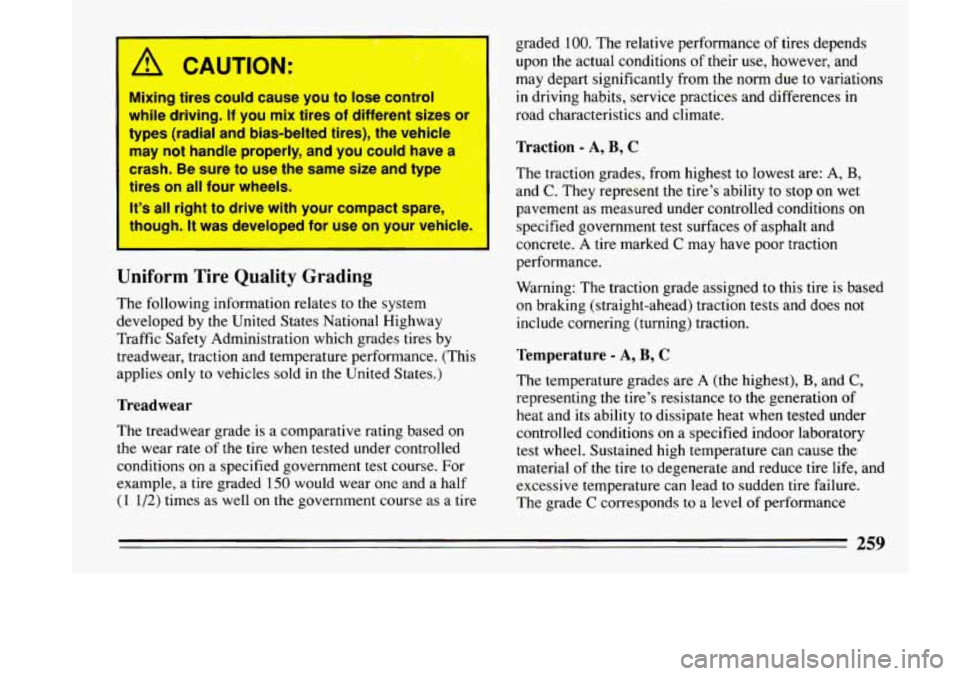
A CAUTION:
;
Mixing tires could cause you to lose control
while driving. If you mix tires of different sizes
or
types (radial and bias-belted tires), the vehicle
may not handle properly, and you could have a
crash. Be sure to use the same size and type
tires
on all four wheels.
It’s all right to drive with your compact spare,
though. It was developed for use on your vehicle.
I I
Uniform Tire Quality Grading
The following information relates to the system
developed by the United States National Highway
Traffic Safety Administration which grades tires by
treadwear, traction and temperature performance. (This
applies only to vehicles sold in the United States.)
Treadwear
The treadwear grade is a comparative rating based on
the wear rate of the tire when tested under controlled
conditions on a specified government test course. For
example,
a tire graded 150 would wear one and a half
(1 1/2) times as well on the government course as a tire graded
100. The relative performance
of tires depends
upon the actual conditions
of their use, however, and
may depart significantly from the norm due to variations
in driving habits, service practices and differences in
road characteristics and climate.
Traction - A, B, C
The traction grades, from highest to lowest are: A, B,
and C. They represent the tire’s ability to stop on wet
pavement as measured under controlled conditions
on
specified government test surfaces of asphalt and
concrete.
A tire marked C may have poor traction
performance.
Warning: The traction grade assigned to this tire
is based
on braking (straight-ahead) traction tests and does not
include cornering (turning) traction.
Temperature - A, B, C
The temperature grades are A (the highest), B, and C,
representing the tire’s resistance to the generation of
heat and its ability to dissipate heat when tested under
controlled conditions on a specified indoor laboratory
test wheel. Sustained high temperature can cause the
material
of the tire to degenerate and reduce tire life, and
excessive temperature can lead to sudden tire failure.
The grade
C corresponds to a level of performance
Page 315 of 324
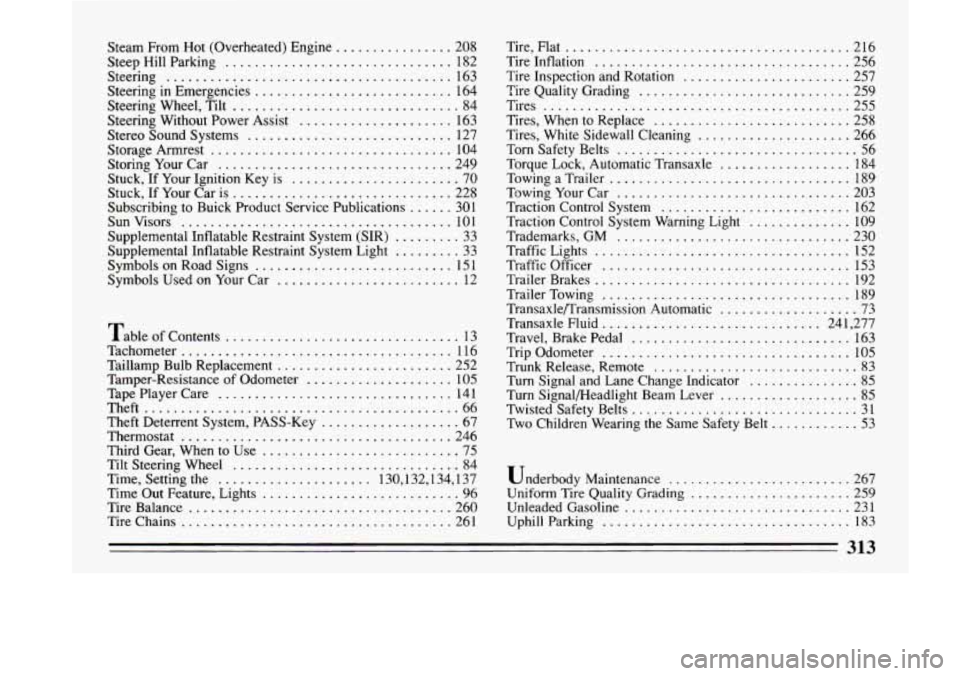
Steam From Hot (Overheated) Engine ................ 208
Steep Hill Parking
............................... 182
Steering
....................................... 163
Steering in Emergencies
........................... 164
Steering Wheel. Tilt
............................... 84
Steering Without Power Assist ..................... 163
Stereo Sound Systems
............................ 127
Storage Armrest
................................. 104
Storing Your Car
................................ 249
Stuck. If Your Ignition Key
is ....................... 70
Stuck. If Your Car is
.............................. 228
SunVisors
..................................... 101
Subscribing to
Buick Product Service Publications
...... 301
Supplemental Inflatable Restraint System
(SIR) ......... 33
Supplemental Inflatable Restraint System Light
......... 33
Symbols on Road Signs
........................... 15 1
Symbols Used
on Your Car ......................... 12
Table of Contents
................................ 13
Tachometer
..................................... 116
Taillamp Bulb Replacement
........................ 252
Tamper-Resistance of Odometer
.................... 105
TapePlayerCare
................................ 141
Theft
........................................... 66
Theft Deterrent System. PASS-Key
................... 67
Thermostat ..................................... 246
Third Gear. When to Use
........................... 75
Tilt Steering Wheel
............................... 84
Time. Setting the
..................... 130.132.134. 137
Time Out Feature. Lights
........................... 96
Tire Balance
.................................... 260
Tire Chains
..................................... 261 Tire. Flat
....................................... 216
Tire Inflation
................................... 256
Tire Inspection and Rotation
....................... 257
Tire Quality Grading
............................. 259
Tires
.......................................... 255
Tires. When
to Replace ........................... 258
Tires. White Sidewall Cleaning
..................... 266
Torn Safety Belts
................................. 56
Torque Lock. Automatic Transaxle
.................. 184
Towing a Trailer
................................. 189
TQwing Your Car ................................ 203
Traction Control System
.......................... 162
Trademarks.
GM ................................ 230
Traffic Lights
................................... 152
Traffic Officer
.................................. 153
Trailer Brakes
................................... 192
Trailer Towing
.................................. 189
Transaxleflransmission Automatic
................... 73
Transaxle Fluid
.............................. 241. 277
Travel. Brake Pedal
.............................. 163
Trip Odometer
.................................. 105
Trunk Release. Remote
............................ 83
Turn Signalmeadlight Beam Lever
................... 85
Twisted Safety Belts ............................... 31
Traction
Control System Warning Light
.............. 109
Turn Signal and Lane Change Indicator
............... 85
Two Children Wearing the Same Safety Belt ............ 53
Underbody Maintenance ......... .... ... ... ...... 267
Uniform Tire Quality Grading
...................... 259
Unleaded Gasoline
............................... 231
Uphill Parking
.................................. 183
. 313
Page 316 of 324
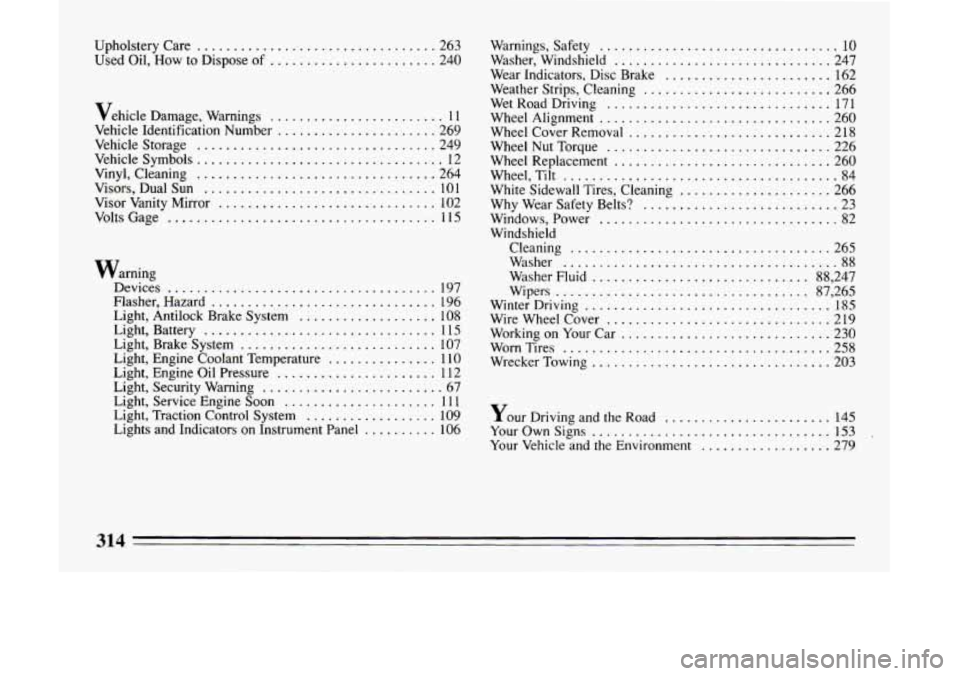
Upholstery Care ................................. 263
Used Oil. How to Dispose
of ....................... 240
Vehicle Damage. Warnings
........................ 1 1
Vehicle Identification Number
...................... 269
Vehicle Storage
................................. 249
Vehicle Symbols
.................................. 12
Vinyl. Cleaning
................................. 264
Visors. Dual
Sun ................................ 10 1
Visor Vanity Mirror .............................. 102
Volts Gage
..................................... 11 5
Warning
Devices
..................................... 197
Flasher. Hazard
............................... 196
Light. Antilock Brake System
................... 108
Light. Battery
................................ 1 15
Light. Brake System
........................... 107
Light. Engine Oil Pressure
...................... 1 12
Light. Security Warning
......................... 67
Light.
Engine Coolant Temperature
............... 11 0
Light. Service Engine Soon ..................... 11 1
Light. Traction Control System
.................. 109
Lights and Indicators
on Instrument Panel .......... 106 Warnings. Safety
................................. 10
Washer. Windshield .............................. 247
Wear Indicators. Disc Brake
....................... 162
Weather Strips. Cleaning
.......................... 266
Wet Road Driving
............................... 171
Wheel Alignment
................................ 260
Wheel Cover Removal
............................ 218
WheelNutTorque
............................... 226
Wheel Replacement
.............................. 260
Wheel. Tilt ...................................... 84
White Sidewall Tires. Cleaning
..................... 266
Why Wear Safety Belts?
............................ 23
Windows. Power
................................. 82
Cleaning .................................... 265
Washer
...................................... 88
Washer Fluid
.............................. 88. 247
Wipers
................................... 87. 265
Winter Driving
.................................. 185
Wire Wheel Cover
............................... 219
Working on Your Car
............................. 230
Worn Tires
..................................... 258
WreckerTowing
................................. 203
Windshield
Your Driving and the Road ....................... 145
Your Own Signs
................................. 153
Your Vehicle and the Environment .................. 279
314